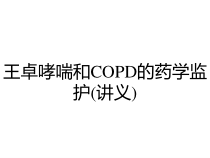 PPT
PPT
【文档说明】王卓哮喘和COPD的药学监护讲义课件.ppt,共(53)页,569.521 KB,由小橙橙上传
转载请保留链接:https://www.ichengzhen.cn/view-236766.html
以下为本文档部分文字说明:
王卓哮喘和COPD的药学监护(讲义)⚫药学监护的理解与回顾⚫实施药学监护的标准模式⚫临床药师提供的药学监护⚫哮喘患者药学监护要点⚫COPD患者药学监护要点药学监护的理解与回顾pharmaceuticalcare⚫药学监护
来源于美国,国内又称药学服务。⚫其核心思想是通过药师与临床医护人员共同协作,为病人提供直接负责的药物治疗,并积极监测治疗的全过程,以改善病人的治疗效果,最终提高病人的生活质量为目标。药学服务的目的⚫获得改善病人生活质量的既定结果
。⚫包括:⚫①治愈疾病;⚫②消除或减轻症状;⚫③阻止或延缓疾病进程;⚫④防止疾病或症状的再次发生。Introduction⚫PharmaceuticalCareThedirect,responsibleprovisio
nofmedication-relatedcareforthepurposeofachievingdefiniteoutcomesthatimproveapatient’squalityoflife(ASHPState
mentonPharmaceuticalCare)WhatapharmacistdoestoimprovepatientcareandpatientsafetyPharmaceuticalCare⚫Apatient-centeredpractice⚫Practitionerassumesresp
onsibilityforapatient’sdrugrelatedneeds⚫Practitionerisheldaccountableforthecareprovided工作开展⚫药学监护是药师在临床疾病治疗中参与并主导的一种工作过程,是多学科协作综合地考虑整体诊疗计划的前提下
,从药学角度对治疗计划进行合理的设计、执行、监测和及时调整,实施过程需要患者和医护人员紧密协作。工作职责⚫药师对治疗结果负责至少表现为以下三个方面:⚫①发现潜在的或实际存在的用药问题;⚫②解决实际发生的用药问题;⚫③防止潜在的用药问题发生。药学监护与
药物治疗⚫药物治疗是临床治疗的主要方式之一⚫药物治疗是多学科协作的临床服务⚫药学监护是优化药物治疗的主要手段⚫药学监护是临床药师的工作核心实施药学监护的标准模式•ASHPguidelinesonastandardizedmethodforpharmaceuticalca
re.AmJHealth-SystPharm.1996;53:1713–6.FunctionsofPharmaceuticalCare•Collectingandorganizingpatient-specificinfo
rmation,•Determiningthepresenceofmedication-therapyproblems,•Summarizingpatients’healthcareneeds,•Specifyingpharmacotherapeuticgoals,•Designinga
pharmacotherapeuticregimen,•Designingamonitoringplan,•Developingapharmacotherapeuticregimenandcorrespondingmonitoringplanincol
laborationwiththepatientandotherhealthprofessionals,•Initiatingthepharmacotherapeuticregimen,•Monitoringtheeffe
ctsofthepharmacotherapeuticregimen,and•Redesigningthepharmacotherapeuticregimenandmonitoringplan.CollectingandOrgan
izingPertinentPatient-SpecificInformation••DeterminingthePresenceofMedication-TherapyProblems•Medicationswithnomedicalindication,•Medicalcon
ditionsforwhichthereisnomedicationprescribed,•Medicationsprescribedinappropriatelyforaparticularmedicalcondition,•Inappropriatemedicationdose,dos
ageform,schedule,routeofadministration,ormethodofadministration,•Therapeuticduplication,•Prescribingofmedicationstowhichth
epatientisallergic,•Actualandpotentialadversedrugevents,•Actualandpotentialclinicallysignificantdrug–drug,drug–disease,drug–nutrient,anddrug–labor
atorytestinteractions,•Interferencewithmedicaltherapybysocialorrecreationaldruguse,•Failuretoreceivethefullbenefitofprescribedmedicationther
apy,•Problemsarisingfromthefinancialimpactofmedicationtherapyonthepatient,•Lackofunderstandingofthemedicationtherapybythepatient,and•Failureofthep
atienttoadheretothemedicationregimen.⚫SummarizingPatients’HealthCareNeeds.⚫SpecifyingPharmacotherapeuticGoals.⚫DesigningaPharmacotherapeu
ticRegimen.⚫DesigningaMonitoringPlanforthePharmacotherapeuticRegimen.⚫DevelopingaPharmacotherapeuticRegimenandCorrespondingMonitoringPlan.
⚫InitiatingthePharmacotherapeuticRegimen.⚫MonitoringtheEffectsofthePharmacotherapeuticRegimen.⚫RedesigningthePhar
macotherapeuticRegimenandMonitoringPlan.DevelopingaPharmaceuticalCarePlan⚫Step1.GatheringInformation⚫Thepharma
cistshouldgatheranaccuratemedicationhistory,includingbothprescriptionandnonprescriptionmedicationsandthe
reasonsthemedicationswereprescribedortaken.⚫Thepharmacistwilllikelyhavetoobtainsomeinformationfromthe
physician,suchaslaboratorytestresultsandhospitalizations.⚫Oncethisinformationiscompiled,thepreparationofaPCP(PharmaceuticalCar
ePlan)canbegin.⚫Step2.IdentifyingProblems⚫Fromthepatient'smedicationprofile,onlyoneproblemisevident:diag
nosisofasthma.Ifapplicable,otherproblemshouldalsobelisted.⚫Subjectivefindingsarethosethatthepatientdescribes(e.g.,'Ifeeltiredal
lthetime,“Ifeelbloated,”or"Iwokeupcoughing").⚫Objectivefindingsarethosethatcanbeobservedormeasuredbythepharmacist(e.g.,patientappearstired,b
loodpressureis180/105,pittingedemainankles).⚫Inthepatientwithasthma,thepharmacistwouldhavethepatientuseapeakexpiratoryflowmeterandrecordtheresults.
⚫Step3.AssessingProblems⚫Thepharmacistanalyzesandintegratestheinformationgatheredinsteps1and2anddrawsconclusionsinprepara
tionfordevelopingapatient-specificPCP.⚫Forexample,intheasthmacase,thepharmacistmayfirstinvestigatetheetiologyofthefactorsthatexacerbatedt
heasthma.⚫Thepharmacistshouldattempttodetermineifdrugs(eg.,aspirin,nonsteroidalanti-inflammatoryagents,orbeta-blockers)causedorexacerbatedtheasth
mainthepatient.Thus,theimportanceofanaccurateandcompletedrughistorybecomesevident.⚫Next,thepharmacistassessesth
eseverityoftheasthma.ThiscouldbeaccomplishedbydeterminingthePEFR,examiningthepatient'sdailysymptomandpe
akflowdiary,ordeterminingifthepatienthadbeenhospitalizedandplacedonsteroidsoramechanicalventilator.⚫Step4.Developingth
ePlan⚫Thepharmacistestablishesgoalslinkedtoeachofthepatient'sproblemsandspecifiesacourseofactionaimedatmeetin
geachgoal.⚫Eachgoal(i.e.,desiredimprovement)shouldbestatedintermsofmeasurableoutcomesthatindicatetheextenttowhichthepart
icularproblemhasbeenresolved.⚫Often,thepatienthasseveralproblems,andtheplanmustbecomprehensiveenoughtohaveapositiveeffectontheoverallhealth
ofthepatient.⚫Step5.EvaluatingtheAchievementofOutcomes⚫OutcomesthatwillbeusedtoevaluatethesuccessofthePCPtreatmentplanmustbemeaningful,mea
surable,andmanageable.⚫Outcomesarespecific,measurableindicatorsforthegoalsoftreatment.Thus,theyshouldbe
identifiedintheplanningprocess.⚫Theoutcomeslistedforasthmawouldinclude,butnotbelimitedto,⚫lowerfrequencyandseverityofacuteexacerbations
,⚫fewerphysicianofficevisits,⚫eliminationofsideeffects,⚫PEFRsthatneverfallbelow80%ofpreviouspersonal-bestpredictedrates,⚫feweremergencydepartm
entvisits,⚫maintenanceofactivitiesthatenhancethepatient'squalityoflifeandmayhavebeenlimitedbythedisease.⚫Docume
ntationshouldincludethesecomponents.1.Patientdatasuchasname,medicalrecordnumber,location,dateofhospitaladmission(ifapplicable).ag
e,sex,height,weight,knownmedicationorotherallergies,andmedicationhistory.2.Nameofpharmacist(s)responsiblefordevelopingandimplementingth
ePCP.3.Patientproblem(s)listedIndividuallyinorderofpotentialpharmacotherapeuticimpact(highesttolowestpriority)
.4.Dateonwhichapatientproblemisidentified.Manydiseasesremainchronicthroughoutthepatient'slife.Problemssuchasurinarytractinfectionoru
pperrespiratorytractinfectionusuallyresolvein10to14days.临床药师提供的药学监护•哮喘的药学监护•COPD的药学监护支气管哮喘诊断流程图病史典型•反复发作喘息、气急、胸闷或咳嗽•多与接触刺激性因素有关。•症状可缓解•有节律性波动规律
不典型体检异常•哮鸣音•呼气相延长无异常发现肺功能通气功能PEF监测阻塞性障碍正常舒张试验激发试验排除其他肺部疾病阳性变异率正常阴性阳性阴性COPD?哮喘的分级持续有症状体力活动有限每天有症状影响活动和睡眠每周1次,但<每天1次频繁≥每周1次>每个月2次,但<每周1次60%预计
值变异率>30%60-80%预计值变异率>30%80%预计值变异率20-30%治疗前哮喘病情严重程度分级症状夜间症状FEV1或峰流速重度持续(第4级)中度持续(第3级)轻度持续(第2级)间歇状态(第1级)<每周1次,发作间歇无症状GIN
A2010≤每个月2次80%预计值变异率<20%哮喘分级用药建议轻度持续重度持续中度持续舒利迭50/100bid-50/250bid舒利迭50/250bid间歇发作辅舒酮125必可酮®250或1喷qd辅舒酮125必可酮®250或1喷,bidICS+LABA万托林按
需使用辅舒酮®125必可酮®250+或1-2喷,qd若控制不好,此建议仅供参考,具体详见GINA2002一级二级三级四级降级治疗间断发作轻度持续中度持续严重持续适级开始治疗哮喘控制至少3个月降级治疗哮喘长期治疗分级方案GlobalInitiativeforAsthma(2009
)哮喘的管理模式哮喘管理计划教育评价和监护哮喘避免诱因急性发作的治疗计划规律随访GlobalInitiativeforAsthma建立个人诊治计划在病区开展药学监护的一般程序步骤1了解病情Patient步骤2审核方案
Review步骤3确定方案Decision步骤4方案注释Annotation步骤5监护要点Carepoints步骤6用药教育Education步骤7观察反应Monitor步骤8评估反馈Assessment全面了解患者目前病情、治疗目标和用药史确认药物选择、给药方法安全、适当
帮助患者优化用药方案制定用药方案执行细节用药过程中加强安全性和有效性观察的要点及节点加强患者对医嘱的理解和正确执行,提高依从性和疗效观察药物治疗的效果和各种不良反应对现行治疗方案进行评估,并进一步优化步骤1了解病情步骤
2审核方案步骤3确定方案步骤4方案注释步骤5监护要点步骤6用药教育步骤7观察反应步骤8评估反馈主要目的步骤1:了解病情⚫病人一般情况:年龄、性别、身高、体重、职业等;⚫特殊病理生理:老年、儿童、哺乳、妊娠;肝、肾功能、特
殊用药史、药物不良反应史;⚫疾病情况:病变部位、范围、病因、诱因;疾病分型、分期、分度;并发症、并存疾病;⚫治疗目标:⚫理想目标和可行目标⚫主要矛盾和次要矛盾:轻重缓急疾病情况⚫肺炎:感染部位、范围、
分型、严重程度、病原…⚫支气管哮喘:分期、分级…⚫COPD:分期、肺功能分级、诱因、并发症(感染、心衰、呼衰)…⚫肺癌:细胞分型、分级、分期…方式与特点⚫通过问诊、体检、观察及阅读病历及各类检查资料,了解与药疗有关的基本情况⚫药师与患者直接接触
、与医护人员合作步骤2:审核方案⚫药物选择是否适当:品种、规格、剂量、适应证、禁忌证;⚫给药方法是否正确:给药途径、给药时间、给药疗程、配伍情况、联用情况;⚫是否还有优化可能:有无遗漏、有无重复、有无更佳的替代方式与特点⚫每当新开处方或治
疗方案更改时审核处方,特别要考虑患者的病理、生理状况及合并用药之间的相互作用,考虑药物的不良反应与治疗利益的相互关系⚫药师与医生紧密协作步骤3:确定方案⚫确定药品、联合用药、配伍品种;⚫确定给药剂量、给药时间、疗程;⚫确定给药途径和方法方式与特点⚫了解患者的具体情况,
并考虑所用药物的药代/药效学特点,优化并确定给药方案⚫药师充分发挥药学理论与医生合作确定。步骤4:方案注释⚫注释药品领取细节;⚫注释药品溶解、配伍细节;⚫注释药品运送保存细节;⚫注释给药浓度、速度、步骤、顺序细节;方式与特点⚫对用药方案的执行细节进行药学注释,如静脉给药时的滴速、稳定性、用药
中应观察的指标等注意事项;吸入剂的正确使用方法和注意事项⚫药师与护理人员及患者相互交流、共同协作步骤5:监护要点⚫医嘱是否按时执行?⚫给药顺序、给药方法是否符合医嘱?⚫是否注意特殊要求?⚫给药过程中有无特殊反应?⚫给药
后如何、何时、观察哪些疗效指标?⚫如何预防、发现、鉴别、处理ADE?方式与特点⚫在用药过程中监护患者正确用药情况,观察静脉药物滴速是否准确,观察患者的各种反应;若有不良反应及时进行调整和处理⚫药师严密观察患者的用药情况,随时与医护人员及患者沟通反馈步骤6:用药教育⚫患者对用药教育的
需求⚫疾病对用药教育的需求⚫药物对用药教育的需求⚫常规对用药教育的要求方式与特点⚫可以贯穿于用药前、用药过程中及用药后,运用各种方式纠正患者的用药偏差⚫药师与患者以各种方式交流,并取得患者信任步骤7:观察反应
⚫观察指标、时间、频率⚫分析、鉴别、评价⚫特殊情况的处理预案方式与特点⚫药师及护理人员通过对给药过程观察及与患者交流和进行相关指标的检查,观察治疗效果,如观察患者肺功能、动脉血气、血常规等感染相关指标以及临床表现等情况,及时分析和发现潜在药物相关问题。⚫药师与护理人员协作观察,并与医
生及时交流步骤8:评估反馈⚫原有治疗方案是否达到预期效果?⚫病情有何发展变化?⚫原有治疗目标是否需要调整?⚫患者对现有治疗方案的依从性和耐受性如何?⚫是否有必要对现有方案进行调整?⚫如何调整?方式与特点⚫通过一个阶段药物治
疗效果的观察,结合目前病情变化,对现行药物治疗方案进行调整;若疗效不佳时,既要考虑到治疗方案本身的问题,也要考虑对病情估计不全面导致治疗目标的不准确,因此必要时应重新确定治疗目标。⚫药师可以通过记录药历或病例分析的形式对治疗方案综合分析,并书面或通过病例讨论或与
医生口头交流时提出下一步建议。谢谢!
 辽公网安备 21102102000191号
辽公网安备 21102102000191号
 营业执照
营业执照